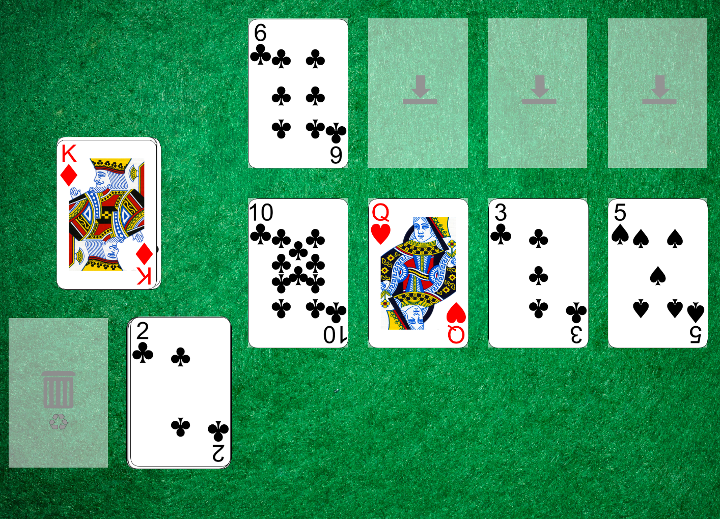How to play: Canfield solitaire
Canfield (also known as Demon solitaire) shares some similarities with other solitaire games
such as Klondike, but is played with fewer tableau piles. The foundation piles do not necessarily
start with aces. Canfield is a relatively difficult game to complete, and in it original version, only a handful of cards can typically be placed on to the foundations. The version of Canfield for iPad and macOS included in the Solitaire Whizz compendium makes a small concession to the way redeals work in order to make the game more interesting.
Layout
Canfield is played with a single shuffled deck of cards. The initial cards are laid out as follows:
- Four tableau columns are started with one card each.
- One card starts the first foundation: this is any card chosen at random
from the shuffled deck and may or may not be an Ace (in the example layout below, a 6 was dealt).
- Thirteen reserve cards are dealt to a face up pile, of which the top card is available.
- The remaining cards form a face up stock pile next to the empty waste pile.
An example Canfield layout will therefore appear as follows:

Aim of the game
The aim of the game is to build all cards on to the foundations, starting with cards of the
same denomination as the randomly chosen card that started the first foundation. In the example above,
all foundations will therefore start with a 6.
In reality, it is difficult to complete Canfield and a more realistic goal is to aim to beat
your previous progress record!
Game play
Cards are built according to the following rules, which include a few special cases not found
in other solitaire games:
- Cards are built on to the foundations in ascending suit sequence. If the starting foundation card is an Ace, then cards will be built Ace to King. Otherwise, cards "wrap" so that there are 13 cards on each foundation, with Aces built on top of Kings. In the example above, founations are built 6 to King, then from Ace to 5.
- On the four tableau piles, cards are built in downward sequence of alternating colours, in a similar way to the game of Kondike solitaire. As in Klondike, correctly formed sequences of cards may be moved together. Unlike Klondike, Kings may be built on to Aces.
- The thirteen reserve cards may be moved to a foundation or column as appropriate. When moved to a column, they must respect the downward alternating sequence, or moved to an empty column.
- The top card of the stock pile can be moved to a foundation or tableau column,
respecting the card sequence in either case. Alternatively, it can be moved to the waste pile.
- The top card of the waste pile is also available to play on to a foundation or tableau column. Again, the correct upward or downward sequence must be respected.
- A special rule determines when cards can be moved from the stock and discard piles to an empty column (see below).
Special rule for moving cards to an empty column
Canfield solitaire has a special rule for moving cards to an empty tableau column. Normally, only cards from the reserve may be moved to an empty column. However, if the reserve is empty, then the top cards of the stock or discard piles may also be moved to empty columns.
Because of this rule, the thirteen reserve cards serve to "orchestrate" the game to some extent, and will often determine when a new opening becomes available during play.
Redeals
In the version of Canfield included with Solitaire Whizz for iPad and macOS, up to 2 redeals are permitted.
In a redeal, the discard pile is shuffled and the cards dealt back on to the stock pile ready for you to go through them again. Note that the reserve pile is not affected by a redeal.
In some alternatives, including what is probably the original gambling game, unlimited redeals are permitted. But cards are dealt in threes from the stock, meaning it is likely that some cards will become unavailable. For the iPad and macOS version of Canfield, it was felt that the game would be more interesting if this restriction was relaxed, and more cards could on average be built on to the foundations.